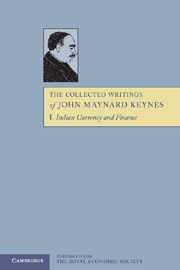Book contents
- Frontmatter
- Contents
- General introduction
- Editorial foreword
- Preface
- Dramatis personae
- 1 THE PRESENT POSITION OF THE RUPEE
- 2 THE GOLD-EXCHANGE STANDARD
- 3 PAPER CURRENCY
- 4 THE PRESENT POSITION OF GOLD IN INDIA AND PROPOSALS FOR A GOLD CURRENCY
- 5 COUNCIL BILLS AND REMITTANCE
- 6 THE SECRETARY OF STATE'S RESERVES AND THE CASH BALANCES
- 7 INDIAN BANKING
- 8 THE INDIAN RATE OF DISCOUNT
- Index
- Chart showing the rate of discount at the Presidency Bank of Bengal
6 - THE SECRETARY OF STATE'S RESERVES AND THE CASH BALANCES
Published online by Cambridge University Press: 05 November 2012
- Frontmatter
- Contents
- General introduction
- Editorial foreword
- Preface
- Dramatis personae
- 1 THE PRESENT POSITION OF THE RUPEE
- 2 THE GOLD-EXCHANGE STANDARD
- 3 PAPER CURRENCY
- 4 THE PRESENT POSITION OF GOLD IN INDIA AND PROPOSALS FOR A GOLD CURRENCY
- 5 COUNCIL BILLS AND REMITTANCE
- 6 THE SECRETARY OF STATE'S RESERVES AND THE CASH BALANCES
- 7 INDIAN BANKING
- 8 THE INDIAN RATE OF DISCOUNT
- Index
- Chart showing the rate of discount at the Presidency Bank of Bengal
Summary
The Indian authorities have undertaken a double responsibility. They must be prepared to supply rupees in payment for council bills or in exchange for sovereigns. And on the other hand they must be prepared also to supply sterling or sterling drafts in exchange for rupees. The maintenance of the Indian system depends on their ability to fulfil this double obligation to whatever extent may be required of them.
The objects to be attained are simple, but the methods of the government are, largely for historical reasons, exceedingly complicated. I will discuss, first, the nature of the existing methods; second, their adequacy for their purpose; third, some proposals for making them more orderly and intelligible; and lastly, the management of the cash balances.
From the profits of rupee coinage a reserve has been built up expressly for the purpose of supporting exchange. This is known as the gold standard reserve. As the reserve is used in practice not only for holding sterling reserves but also for holding a part of the rupee reserve, this title is a misnomer.
For some years after the closing of the mints no fresh coinage was undertaken. By 1900 it had become necessary to mint additional rupees, and from that time until 1907 the profits on coinage rapidly raised the gold standard reserve to a respectable total. The crisis of 1907–8 made it necessary to withdraw a great number of rupees from circulation, and no further coinage was necessary on a significant scale until the autumn of 1912.
- Type
- Chapter
- Information
- The Collected Writings of John Maynard Keynes , pp. 88 - 137Publisher: Royal Economic SocietyPrint publication year: 1978



